Written by Joel T. Lewis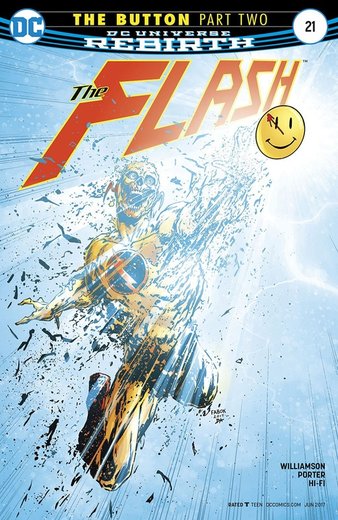 Issue 21 is the very first Flash comic I’ve ever read, and while it’s choked with exposition and flashbacks to the more important components of the Flashpoint and Rebirth events that have led to the mystery of the Button, the charm of pairing up Flash and Batman shines through. When brought together for cosmic level capers that warrant the might of the Justice League, Flash and Batman are often paired off so that the plucky optimism of the former can bounce off the stern seriousness of the latter, but the pairing often feels forced. Flash 21 reminds us that though the ranks of the Justice League are populated by Amazons, Martians, and Kryptonians of supreme power, there are only two true investigators on that team. As Barry’s internal monologue takes us through his analysis of Batman and Reverse Flash’s brawl, he ruminates over the comradery that he and Batman share when it comes to the deconstruction of crime scenes. Though his internal commentary is heartwarming, Barry is troubled by the implications of Reverse Flash’s appearance and takes little solace in the death of his mother’s murderer. The strange topsy-turvy world of Flashpoint looms so large in his mind that it’s possible resurgence overshadows his arch nemesis’ demise. As Barry comes to the end of his lightning fast investigation he turns to a particularly battered Dark Knight for further insight into the reappearance of Reverse Flash. Batman reveals that his father, the Flashpoint Batman, appeared just before Reverse Flash as a result of the mysterious button’s reaction with Psycho-Pirate’s mask. Bruce’s frustration with their lack of progress unravelling the mystery of the button causes him to second-guess Barry’s thoroughness in the lab. This leads to a rare moment of Bat-humility as Bruce apologizes, indicating his respect for the Flash’s instincts as an analyst. This tense moment is actually quite sweet as Bruce reminds himself that Allen is no rank amateur. Barry runs off the continue his investigation leaving Batman to recover and rest. Barry makes his way to the Justice League Watchtower in pursuit of the infamous Cosmic Treadmill which allows those who can run fast enough the ability to travel through time and space. A decidedly silly contraption, much maligned by comic book fans, the Cosmic Treadmill was a pleasant splash of levity (at least to me) in an issue that had been mostly grim until this point. As Barry prepares to travel back to the Flashpoint reality, he is surprised by the appearance of a still-recovering Batman who insists on coming along. The unlikely duo’s journey through space and time is where Howard Porter’s artwork truly shines, depicting classical representations of the Justice League from continuities past while colorist Hi-Fi sends our heroes tumbling through a technicolor thunderstorm of vibrant blues and yellows. The two heroes arrive in an eerie echo of the Batcave and issue 21 of the Flash ends when Thomas Wayne Batman and Bruce Wayne Batman finally meet. Author Joshua Williamson and his creative team do a masterful job of picking up the Button storyline from Tom King and company and portray a well-crafted and compelling Barry Allen. I was nervous being so new to the Flash coming into issue 21, but Williamson does a great job of filling in the details of Flashpoint and Rebirth so that you quickly understand the horrors Allen has seen and the responsibility he feels as the cause of the Flashpoint deviation. In many ways the Rebirth event felt like DC hard-resetting after the chaos of Flashpoint, but it is very important for the character of Barry Allen, as the critical participant in both events, to bear the weight of that terrible alternate reality. The maturity that comes from navigating that cataclysmic shift in reality is quite refreshing to see in a relatively light-hearted (as light-hearted as DC gets) hero. What happens when the Dark Knight meets the twisted foil his father became in an alternate reality? Will the Batmen and the Flash be able to uncover the mystery of the button? What did Reverse Flash encounter that burned him down to the bone? All I can say is that I’ll be reading Batman 22 'The Button Part 3' desperate to find out. Until next time, Geek On!
0 Comments
Written by Joel T. Lewis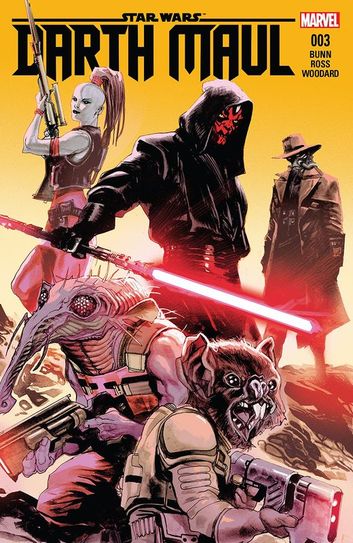 Unfortunately, the most accurate description I can give of Cullen Bunn’s third issue of Darth Maul is that it was a disappointing filler issue. The tension from the final panels of issue 2 where Maul and the kidnapped Jedi Padawan meet face to face is promptly deflated by an issue that does little more than set up the main set-piece for the next issue. Maul is discovered snooping around the captive Padawan’s detention cell but is immediately let off the hook by the criminal auction host, Xev Xrexus. Discovering that they will be unable to compete with the high-end bidders at the Padawan auction, Maul and his bounty hunter band plan to ambush the highest bidder, Jee Kra following the auction. This is anticipated by Xrexus who in turn rigs Jee’s ship to explode. As she watches Maul and company drop out of the sky, Xrexus reveals that it was always her plan to stage a free-for-all hunt for the Padawan on the surface of the nearby moon. The little bit of character work that is done in this issue with regards to the title character is a bit grating. Though he casts a shadow of mystery over the whole of the film, Darth Maul only has 2 lines in The Phantom Menace, one of which is pure exposition. The second line, 'At last we will reveal ourselves to the Jedi. At last we will have revenge.' seems to be the guiding inspiration for most author’s interpretation of the character, at least since the Expanded Universe was wiped out. Now with Darth Maul that’s not a bad starting point, but when those two motivations, revenge and revelation, inform every interaction and thought the character has there’s no room for the character to grow. By boxing him in this way, Maul serves little purpose and has little desire to do anything but avenge a borrowed trauma (which we only just learned about in the previous, newly-canon issue) and come out from the shadows of exile. The effect this has, at least in the context of Bunn’s 3rd issue, is that Maul thinks and acts like a petulant child who’s baffled by the galaxy’s general indifference to the Sith and, by extension, himself. At one point the Moogan Jee Kra gives voice to the general confusion that Maul’s presumptuous dialogue inspires, 'Who are you? Am I supposed to know…' Perhaps it’s asking too much to have a character named Maul employ some subtlety and express some larger awareness of his place in the universe, but Maul can as blunt as his name implies without throwing tantrums. The point is that with the Star Wars Canon shakeup a lot of solid characterization of Darth Maul was binned, and Bunn began his series by restoring a lot of the same elements that made the Sith Lord stand out in the old Expanded Universe. But as we roll into issue 3 of the series, the elements of the previous 2 issues that compelled us to keep reading have fallen away. After a refresher first issue, a retread/Star Wars greatest hits second issue, both with incredible art, issue three falls completely flat with the side cast of colorful bounty hunters adding very little to the story other than comic relief. Issue 3 even suffers visually, with none of the sweeping splash pages of massive brawls or colorful aliens that made the first two issues so much fun to read. Also, there is a particularly silly action sequence where Darth Maul uses the force to make his cloak strangle Jee Kra. The result is a bizarre set of panels that reminds me more of Aladdin’s comedic flying carpet than a sinister method of strangulation. Though I have in classic Star Wars fan form thoroughly criticized this issue of Darth Maul, am I excited by the prospect of a 'Most Dangerous Game' style issue where a Padawan and Darth Maul must work together to avoid being murdered by a legion of space criminals? Absolutely I am. There are only two issues left in Cullen Bunn’s Darth Maul miniseries, let’s hope they make up for this one. Until next time, Geek On! Written by Joel T. Lewis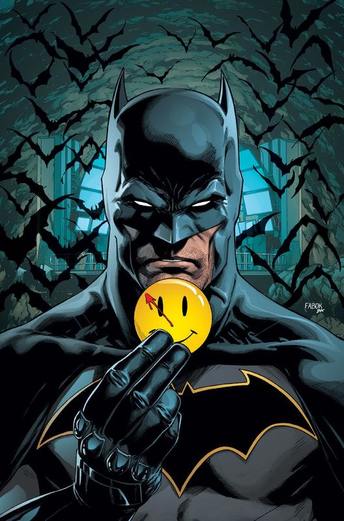 In the past I have expressed that I avoid following massive comic book events in general. In fact, I have never followed one month to month. The time, finances, and publisher loyalty required to read everything in the Flashpoint storyline or World War Hulk for instance are not available to me. That being said, when they announced the DC Rebirth event I was intrigued by the idea that the DC Universe would become intertwined with the Watchmen Universe, but I didn’t rush out to buy every Rebirth issue. Actually, the reason I picked up All-Star Batman was that it had very little to nothing to do with the Rebirth storyline. But now months later, (20 issues of Batman later) author Tom King and artist Jason Fabok have finally begun unravelling the mystery at the heart of the Rebirth event: where did the Comedian’s button come from, and how did it wind up in the Batcave? I’ve been really curious to discover how the creators at DC plan to bridge the gap between these two comic universes so I bit the bullet and jumped on issue 21 of Batman. I was sold on the storyline, but the super-cool holofoil cover didn’t hurt either! That being said what I found inside issue 21 more than delivered on the promise of the holofoil cover. Issue 21 begins with Batman watching a Gotham vs Metropolis hockey game. He’s in the Batcave running an analysis on the button he found embedded in the wall of his lair and when he tosses the button onto his desk it sparks in reaction with another artifact. As a result, the Thomas Wayne Batman from the Flashpoint alternate reality appears and calls out to Bruce. Batman contacts the Flash to help him investigate the disruption this causes in the Speed Force. The Flash is in the midst of a huge brawl and tells Batman that he’ll be there in a minute. One second later, a speedster appears, but it’s not the Flash. Reverse Flash, who died along with the rest of the alternate reality characters from the Flashpoint event, appears and attacks Batman. He notices the note Thomas Wayne wrote Bruce from that alternate timeline and mocks Batman as he rips it to shreds. Now, I’m not an advocate of Batman killing anybody, but after that heart-rending panel I would’ve looked the other way if Bruce were to beat the speedster till his costume resembled the normal Flash’s crimson tint. The fight that follows Reverse Flash crossing that line is one of the best I’ve ever seen in comic books. Now I have little to no interest in the Flash or his villains, but I imagine one of the difficulties that arises when illustrating a super-fast character in a comic book would be avoiding making every feature blurry and stretched to convey how fast that character is moving. This issue masterfully conveys the speed with which Reverse Flash beats the hell out of Batman by dividing each panel into one-second-long intervals with a simple timestamp at the bottom. Batman knows he has to play for time waiting for the arrival of Flash so the only weapons he can fight Reverse Flash with are delay tactics. At one-point, Batman uses a Batarang to pin Reverse Flash’s foot to the floor of the Batcave and proceeds to even the score of what had been a pretty one-sided fight. As the minute ticks down to zero Batman eases up momentarily in anticipation of Flash’s arrival but the speedster is late and Reverse Flash lands a furious final blow. Leaving the crumpled Dark Knight on the floor, Reverse Flash picks up the button and is transported out of the Batcave. When he returns, the villain’s side is burned down to the bone and he screams 'I saw God!' The Flash finally arrives to find both Batman and Reverse Flash collapsed on the floor of the Batcave. Like I said, I’m not a Flash fan, but this issue’s storyline is said to continue in issue 21 of the current Flash series and you can bet that I’ll be picking that one up the day it comes out. This is an outstanding issue and a great jumping on point for the 2017 Batman series though it would be helpful to have some familiarity with the Flashpoint storyline. That being said, you can get the general plot points of that event from the DC animated movie 'Flashpoint' instead of tracking down every issue in that massive arc. Until next time, Geek On! Nerds That Geek Comic Book Review - 'All-Star Batman' #9: 'Ends of the Earth - Part Four: Finale'4/25/2017 Written by Joel T. Lewis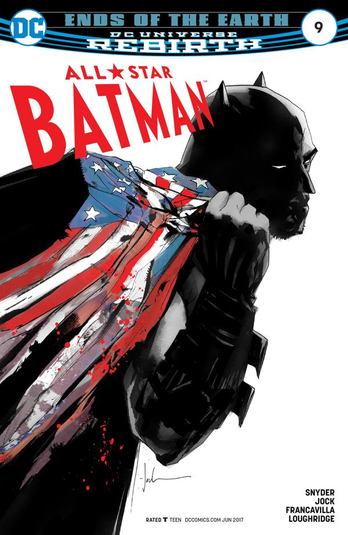 Over the past 8 months I have praised Scott Snyder’s ability to effectively synthesize and showcase Batman villains whether it’s over the course of a large story arc or a single-issue feature. His five issue storyline 'My Own Worst Enemy' brought new depth and intimacy to the relationship between Batman and Harvey Two-Face, and as he’s gone on to feature a single villain per issue with this current run the results have been outstanding. But as Snyder attempted to connect all the threads he had set up in the 3 previous issues of the 'Ends of the Earth' arc, I found that he may have miscalculated the time necessary to do his final villain justice. We find in issue 9 that the man responsible for the near-cataclysmic disasters of the previous 3 issues is none other than Ra’s al Ghul and his scheme for cleansing humanity is all over the place. I feel that this issue was rushed, bloated, and convoluted, and let me stress that I don’t like saying that! Let me attempt to summarize the plot of this issue and you’ll see what I mean. The Blackhawks have captured Duke and have threatened to end his life unless Batman takes out Ra’s al Ghul and stops his master plan. Ra’s is celebrating his victory at the top of the Washington Monument in D.C. as Batman speeds towards the Monument on his Bat-Cycle. As the time limit set by the Blackhawks trickles away, the Bat-Cycle is destroyed sending Batman into the reflecting pool which separates the Lincoln Memorial and the Washington Monument. Ra’s continues to gloat and is struck over the head with a champagne bottle by someone he assumed to be one of his goons. We find out that the person that just flew into the reflecting pool was Selina Kyle in Hatter-tech camouflage and that Bruce Wayne was similarly disguised as one of Ra’s followers. Brandishing a revolutionary musket, Bruce demands to know what Ra’s master plan is and here’s where things really get out of hand plot-wise. Over the course of the last three issues, Ra’s orchestrated the near-disasters that Batman prevented in order to show Bruce how the world might end if left to its own devices. This has all been a way to distract the Dark Knight from the fact that Ra’s has slipped a technology into nuclear reactors and similar sensitive areas around the world which will allow him to cause meltdowns, confusion, and ultimately war on a global scale. Ra’s pontificates on how Batman is more of a detriment to society than Ra’s ever could be because he’s allowed humanity to escape his past schemes and accelerate towards a disaster of their own making. Ra’s then shoots Batman through the head and revels in his victory. But we discover that it’s not a victory after all as Batman reveals that when he hit Ra’s over the head with the bottle of champagne he stuck him with a Mad Hatter tag which convinced Ra’s of a false reality. While Ra’s was monologuing Batman traced the nuclear meltdown signal and stopped the countdown. At the end of the issue we are unsure of whether the Blackhawk team was indeed a distraction as Ra’s al Ghul claimed or an actual strike team in reality and the ominous cell phone which blacks out at the end of the issue seems to indicate that Batman didn’t stop Ra’s plot, he may have only slowed it down. Now this is not a bad Ra’s al Ghul scheme, and I’m not unhappy that Batman was able to counter it. However, the number of bait-and-switch moments in this issue with both Selina and Bruce disguised by Mad Hatter-tech, the Hatter Tag used on Ra’s, and the quick introduction and nearly instantaneous resolution of Ra’s nuclear plot made this issue feel rushed and clunky. I don’t dislike Ra’s al Ghul as a villain, I enjoy this issue as a commentary on the social and political unrest that is very palpable today, and I adore anytime I get to see Jock work on a Batman comic (and his Ra’s al Ghul is amazing!), but this conclusion to the 'Ends of the Earth' storyline just felt like Snyder tried to cram too much into one issue, which was disappointing since he paced his Two-Face storyline so well. Also, I have to say that the set up at the beginning as Ra’s describes the issue as 'not a Batman story' is brilliant and the clash of fundamental ideologies between Batman and Ra’s is really interesting, it’s just an issue that is too crammed with content. Though I was really harsh on this month’s issue, the next chapter of All-Star Batman is supposed to feature an Alfred origin storyline and a brand new villain. This intrigues me and I’m too optimistic about Snyder’s ability to bounce back to give up on All-Star Batman now. Until next time, Geek On! Written by Joel T. Lewis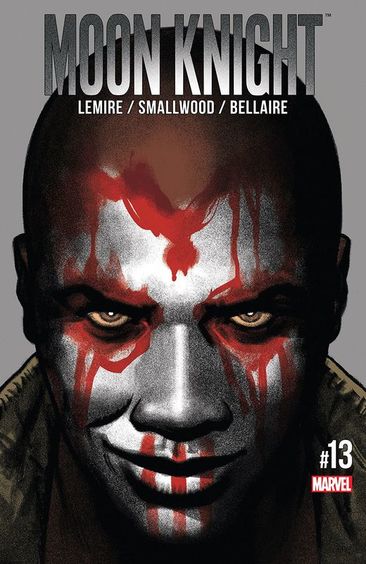 In preparation for this month’s issue I went into the Moon Knight back-catalog and pulled every appearance of the villain Raoul Bushman that I could find and read it again. I took notes on the history of the character and cataloged his atrocities. I tracked his evolution throughout Moon Knight’s history from his start as a vicious international mercenary to his stint as a New York drug lord, from his days as an African Dictator, to his last appearance as a faceless zombie. I had planned to use this research to show how Jeff Lemire’s Bushman fits into the greater history of the character. While this issue does introduce Raoul Bushman and shows the iconic confrontation scene that leads Marc Spector to become Moon Knight...the effect is underwhelming. This is not how I wanted to describe this issue. I was really excited but Lemire’s Bushman falls a little flat for me. Let me explain: this is a character who in his first appearance (Moon Knight (1980) #1) revels in the violence he and his gang of mercenaries bring to the freedom fighters in the Sudan. His face is a tattooed death mask which rivals Darth Maul’s heebie-jeebie factor and to top it all off he brutally murders Marlene’s father by biting out his throat. Now, in issue 13 Bushman does murder Professor Alraune, and he does it by gutting him with an efficiency that is chilling, but the matter-of-fact way he does it is more controlled and removed than Bushman has been in the past. I can’t help but feel let down that I didn’t get to see Greg Smallwood and Jordie Bellaire’s interpretation of Bushman’s filed down teeth taking the life of Professor Alraune the way he does in his first appearance. Now I can think of a number of reasons why Lemire chose to tone the Bushman down for this series, and chances are that we will see the mercenary return in the series finale, but when you pick up an issue with Smallwood’s terrifying Bushman on the cover, the last thing you want is to have that character be underwhelming on the inside. Now that I’ve had my nerd rant, I must say that if this is the first Moon Knight series you’ve ever read, or you came aboard for the 2014 Warren Ellis run, this first introduction to the Bushman isn’t a bad one, nor does it completely mischaracterize the villain. While the flashback storyline follows Spector’s last mission as a mercenary and the introduction of Marlene, not much happens as we follow present day Spector on his journey to confront Khonshu. Marc receives an ominous warning from Anubis as he bids him farewell and Marc sends Crawley to Gena’s diner to protect him from the final showdown with Khonshu. We follow Marc as he makes his way to the subway station where he encountered the Mummies in issue 3 and eventually back to the asylum. Khonshu tempts Marc with the promise of a pain free life if he remains trapped inside his own mind which Marc rejects as he bursts out (rather messily) from a brain-shaped prison. While I have been ragging on this issue, and in all honesty it is a bit of a filler issue, seeing Smallwood trap Spector in a giant brain and a few pages later show him carve his way out with a crescent dart was really cool. Another redeeming aspect of this issue was the way that Marc insulated Crawley from the final showdown with Khonshu. Throughout the history of Moon Knight, Marc has treated his friends and supporting characters the way he treated his different identities, donning each personality and using each friend to accomplish Moon Knight’s goals. In the past, Marc has been a parasitic influence in the lives of Frenchie, Marlene, Gena, and Crawley and it’s a nice subtle touch for him to take on this final battle alone. It’s not as dramatic as acknowledging his separate identities was in issue 9, but it is a great way of showing Marc’s healthier way of interacting with those closest to him. This is it! We’re nearly at the end of this amazing run and while this issue was a bit of a disappointment for me I cannot wait for next month’s finale. Moon Knight VS Khonshu 2017 promises to be epic, intimate, and totally insane. Until next time, Geek ON! Written by Joel T. Lewis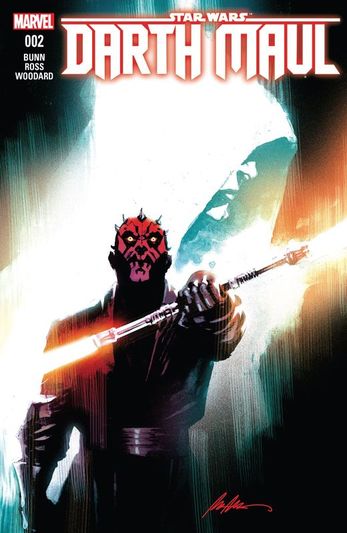 Where last month's issue of Darth Maul acted as a bit of a catch up/primer for the new canon of Darth Maul, issue 2 feels like a retread of Star Wars Greatest Hits. In his search for the Padawan held for ransom by Xev Xrexus, Darth Maul has landed on the “Smuggler’s Moon” of Nar Shaddaa. Now, I'm of the opinion that if Obi-Wan had ventured to this Hutt-controlled moon before the events of Episode IV he might have rethought his characterization of Mos Eisley as the heart of scum and villainy in the galaxy. Needless to say, the Smuggler’s Moon is a rough corner of space and by opening this issue in yet another seedy cantina, author Cullen Bunn automatically invites comparisons to Mos Eisley’s Cantina and the events that transpired there. Now we know, thanks to Obi-Wan Kenobi, that if a Jedi walks into a bar, the odds are pretty good that somebody’s going to lose an arm, but when a Sith does it the collateral damage tends to increase. Darth Maul walks into the bar only to exit it shortly thereafter, dragging several thugs through the newly shattered window into the street. Outnumbered, but hardly outmatched, Maul proceeds to dispatch the throng of malcontents without his lightsaber or the Force for fear of exposing the secret of the Sith too early. His most notable opponent in this first sequence is a squid-faced Quarren named Dirty Calgriz. Luke Ross’ skillful illustrations depict this Quarren employing an unexpected defense mechanism that was both surprising and visually stunning. Apparently the Quarren can spray ink at their opponents in order to blind them. That was an especially refreshing addition to the bar brawl that thoroughly impressed this veteran Star Wars fan. Having backed himself into a tight spot, Darth Maul seems to be on the brink of defeat as the circle of space misfits move in on the temporarily blinded Zebrak, when he is rescued by an unexpected trio: Bounty Hunters Aurra Sing, Vorhdeilo, and Cad Bane. The inclusion of Cad Bane, a fan favorite from the Clone Wars series, is, in my opinion, the second Greatest Hit that this issue relies on. While it is exciting to see the Clint Eastwood-esque blaster-slinger come to rescue of Darth Maul, his presence in the comic doesn’t really add much to a series that’s supposed to be about Darth Maul. It seems to be an odd match up that sounded cool in theory but distracts from Maul’s desire to keep a low profile. As the unlikely foursome pick up the trail of the kidnapped Padawan, we are treated (and it is a treat I assure you) to possibly one of the silliest Darth Maul moments of all time. While interrogating the Haddex Gang’s protocol droid (FE-B3 or “Phee-Bee”) Darth Maul uses the Force to pop its remaining eye assembly out of its head, rendering the droid blind. Meaning to intimidate the droid into revealing the location of Xrexus’ Padawan auction, Maul’s blinding tactic comes across as quaint in the comic. Maul’s hand is so close to Phee-Bee’s face that it’s comical for him to use the Force to blind the droid. He could have just as easily ripped the optical sensor out with his bare hands, but using the Force here causes the desired seriousness of an interrogation to fall into levity. It just looks silly and is so uncharacteristic of the violence we've come to expect from Darth Maul. That being said, the silliness brought a smile to my face (as most interactions with droids do) in a comic that could easily slide into monotonous brooding. I’m sure that this was not the effect that Bunn was shooting for, but it's one of my favorite panels of all time. 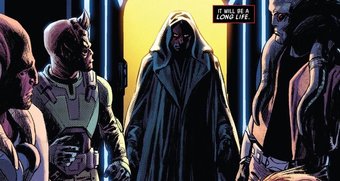 The third Star Wars Greatest Hit that Bunn sets up for Darth Maul is a Force cave sequence. On the way to Xrexus’ auction, Darth Maul’s mediation is interrupted by a flashback to a dead planet where Darth Sidious taught the young Zabrak an important lesson. In a pyramid temple haunted by the restless souls of murdered Sith, Sidious taught Maul the mantra, 'Far above, far below. We don’t know where we’ll fall. Far above, far below. What once was great is rendered small.' Beset by the vengeful souls of ancient Sith whose lives were ended by the first great conflict with the Jedi, Maul uses this mantra to harness and focus generations of rage and pain. Meanwhile, Cad Bane and Aurra Sing discuss the tenuous agreement they've struck with the mysterious Zabrak. Unsure of their future safety, the motley crew arrive at the auction and the issue ends as Maul discovers where the Padawan is being kept. Now, there are some definite issues with this series: dressing up main elements of the original Star Wars trilogy and Clone Wars series in Pre-Clone Wars drag is a little disappointing as it seems to rely too heavily on the iconic elements of its predecessors rather than adding anything new to the Star Wars mythos. That being said, seeing a cantina brawl starring a Darth Maul who’s forced to use hand-to-hand combat and very little of the Force was very entertaining. Additionally, the Force cave-esque flashback did add some much needed depth to Darth Maul’s preoccupation with revenge against the Jedi. Before this issue there was really no basis for Maul’s specific hatred of the Jedi, so the added weight of vengeful Sith spirits filled in that gap nicely. Also, I would be doing this issue’s artist, Luke Ross, a great disservice if I didn't mention the skill with which he is depicting the Star Wars Universe. Issue 2 is splash page city. I don't think I've seen so many two-page spreads even in the massive Marvel Civil War comic event. The trouble with including so many sweeping visuals is that the reader might get lost following the prose and dialogue but somehow, Bunn and Ross have struck a beautiful balance that flows well from panel to panel. Ross manages to give us pages that feel as densely and diversely populated as the Star Wars Universe should without allowing the reader to get lost. Until next time, Geek On! Written by Joel T. Lewis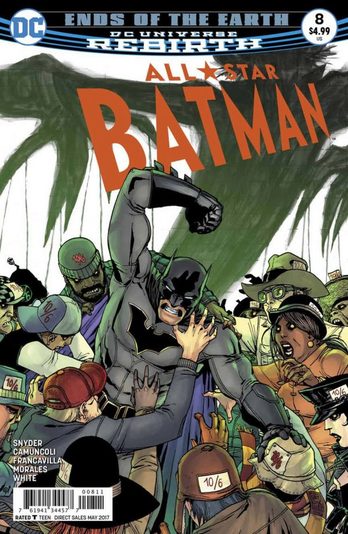 This month it seems that Batman’s efforts to contain the plague set loose by Mr. Freeze have been successful thanks to the cooperation of Pamela Isley but during the course of that mission, Batman and Duke Thomas have been relentlessly pursued by a strike team known as the Blackhawks. This group of operatives are equipped with unique body armor that features an advanced camouflage technology which manipulates how the brain interprets eye movement in order to trick the mind into seeing whatever the user wants. Batman’s research on this advanced technology has led him to the lavish estate of Jervis Tetch and the Dark Knight has some questions for the madcap haberdasher. Upon arriving at the Tetch Estate, Batman is confronted by Nightwing, Batwoman, and Red Hood. Picking up on subtle cues that lead him to believe that these people are not members of the Bat-Family, Batman proceeds to subdue each in turn. The crumbled heap of imposter’s camouflage falls away to reveal members of the Blackhawks. Batman then confronts Mad Hatter directly but quickly falls under the hallucinogenic influence of a gas Jervis has polluted the air with. This coupled with the appearance of more Blackhawks whose camouflage armor shifts and distorts Batman’s grip on reality, sends the caped crusader on a psychedelic journey. The Mad Hatter’s mind control hats and his ability to manipulate his victim’s perceived reality has always made him a formidable opponent, despite his childish obsession with Alice in Wonderland, and this issue is no exception. One of the most fascinating components of the Batman mythos is when an author finds a way to explore an alternative series of events that might have taken place during the formative days of the dark knight. In this issue we get to see a distorted vision of what Bruce Wayne’s life might have been if the Hatter had gotten into his head before he became Batman. That version of reality, while thankfully hallucinatory, is haunting and fascinating. The cerebral focus of this issue is strengthened by the introspective style of narration that Scott Snyder uses. By letting us into Bruce’s thoughts as he navigates the topsy-turvy madness laid out for him by the Mad Hatter, Snyder intensifies our sense of disorientation as Bruce’s confusion becomes our own. Hatter weaves a tale of manipulation going back to the first days of Bruce’s vigilantism, claiming that he slipped one of his reality twisting tags into Wayne’s ball cap and saw him take his first steps into Gotham’s underworld. He also claims to have fabricated the fantasy of Batman by activating the tag he planted with the Alice in Wonderland quote, 'Twinkle, Twinkle, Little Bat.' In this reality, Bruce broke his neck on his first outing into Gotham’s underworld, and Batman is the desperate fantasy of a man confined to a wheelchair. Through this lens, Hatter shows key members of Batman’s rogue’s gallery to be echoes of Alice in Wonderland characters: Monstrous Bane is the Jabberwocky, mischievous Catwoman is the Cheshire Cat, Riddler stands in for the Caterpillar, and Joker and Harley Quinn are the King and Queen of Hearts. Terrifying as this distorted reality is, Batman manages to break through the madness and interrogate the diminutive hat-maker. The issue concludes with Tetch hinting at an unknown villain who’s responsible for mobilizing the Blackhawks. But we’ll have to wait till next month to discover who the unknown puppeteer is as Snyder doesn’t give us any hint as to who the villain might be. Something that continues to impress me about the All-Star Batman series is Scott Snyder’s determination to give Batman a sense of humor. In an issue as psychological and twisted as this month’s was, Snyder’s humor shines through all the more. Instead of taking Batman to the dark and gritty places made famous by authors like Frank Miller, Snyder lets Batman quip and play in a way that breathes new life into the character. That’s not to say that Snyder’s humor is heavy-handed or detracts from the narrative. Snyder adds just a bit here and there like when he’s fighting the Nightwing imposter, Batman clubs him with a mechanical lawn flamingo, like the Queen in Alice in Wonderland does when playing croquet, or when considering how he was able to identify the Blackhawks as impostors Batman says, 'My family knows how to #$%^ fight.' Perhaps my favorite example of Batman’s humor comes when he’s confronting Mad Hatter at the end of the issue, the tiny villain’s voice has turned into a high-pitched whine, to which Batman smirks, 'I let him tell Aquaman.' Snyder keeps enough humanity in this version of Batman to lighten the mood when necessary which allows All-Star Batman to avoid being dreary. Next month we discover the villain behind the Blackhawks! Until next time, Geek On! Joel's One Shot Comic Reviews - 'The Spectacular Spider-Man (1976)' #185: 'Another Fine Mess!'3/20/2017 Written by Joel T. Lewis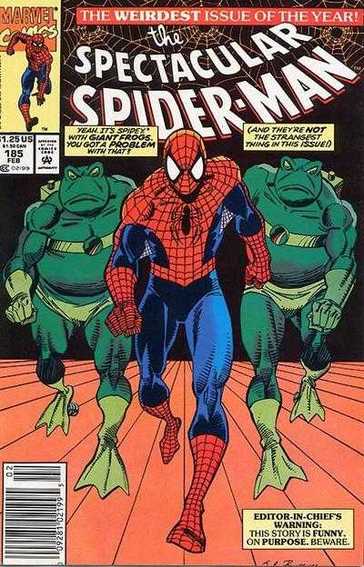 Thank Marvel for cover art. Considering Spidey has a pretty extensive back catalog, I have never felt bad picking up an issue or two in the middle of a series as it would take me years to catch up on everything the web-crawler has been up to. This frees me from my completist impulse to read every panel of a given character and makes the Spider-Man comics section a great hunting ground for cover-based collecting. Issue 185 is a sinfully wacky comic book featuring not one but two Alice in Wonderland themed villains, a fluffy bunny getaway car, and an awkward family dinner with Spider-Man. Not to mention the two men in Frog costumes on the cover! Before I even start in on the storyline of this issue I have to praise this issue’s cover for just dripping confidence. It reads: 'Yeah, it’s Spidey. With giant frogs. You gota problem with that? (And they’re not the strangest thing in this issue!) Editor-in-Chief’s Warning: This story is Funny. On Purpose. Beware.' Eat your heart out Deadpool! Spidey reunites with Eugene Patilio AKA the Fabulous Frog-Man, a hapless youth aspiring to be a superhero. Eugene doesn’t quite have the balance or agility necessary to be a successful crime fighter and Spidey, coming off of a 6-issue Green Goblin story arc, lays into him a little bit about the seriousness of becoming a superhero. Meanwhile, the White Rabbit, a scantily clad femme fatale with razor tipped carrot darts and a mad tea party themed lair, recruits the dimwitted Hubert Carpenter AKA the Walrus to help her exact her revenge on Frog-Man. Feeling guilty for being so harsh with him, Spidey decides to take Eugene up on his invitation to have dinner with his family. Now, don’t mistake my meaning, Spider-Man goes to an awkward family dinner. Not Peter Parker. Guess who’s coming to dinner? Your friendly neighborhood Spider-Man. Eugene’s a sweet kid and his father Vincent (formally the villain Leap Frog) is kind and plays the friendly host well enough, but it's just so funny to see Spider-Man in such a domestic setting, having the same silly small talk conversation that you’d have with an aunt you haven’t seen in a while. 'So--how’re things going with you, Spidey? How’s work...how’s the family...nice weather we’re having, huh?' This awkward interaction is probably one of my favorite things I’ve ever read in a comic book mainly because of its silliness, but also because it highlights how difficult it must be for Peter Parker to interact with people. When the majority of your life is taken up by colossal threats to your family and your way of life, talking about the weather and your day job can seem even more trivial than normal. As Spidey plays the dinner guest he demonstrates that Spider-Man must tread lightly in casual conversation the way Peter Parker does. Showing how difficult the double-life of a superhero can be in this unique context is fascinating because it makes you think about how easy it would be to slip and reveal your secret identity in a domestic setting while presenting yourself as Spider-Man. Even the process of eating dinner becomes difficult as Spidey lifts up the bottom of his mask to have more of Aunt Marie’s pasta. This issue is very aware of how silly comics can be, and offers a subtle commentary on what comic fans take for granted and how far they will suspend their disbelief. When Parker mentions how silly a Frog-themed superhero is by calling Eugene’s costume dumb, Mary Jane replies, 'You think those blue and red longjohns of yours are so fashionable?' The point she’s making is that a Frog-Man is no more ridiculous than a Spider-Man and we just take Spidey’s existence for granted because we’ve grown to love the character over the years. Author J.M. DeMatteis makes a similar comment on how villains make their plans when the Walrus questions White Rabbit’s scheme for drawing out Frog-Man. White Rabbit says, 'We are doing what all super-villains do when they want the attention of their arch-enemies: Creating general Mayhem and Havoc.' Confused, the Walrus replies, 'Wouldn’t it be better if we just robbed a bank and went to Acapulco?' White Rabbit sighs and says, 'You are never going to get anywhere in life thinking like that.' While the Walrus is portrayed as pretty dimwitted in this issue, his point is valid: if super-villains didn’t get hung up on revenge schemes and ploys to draw out their enemies, they would probably be more successful. But that doesn’t jive with what we’ve come to expect from comic book villains and we take schemes like White Rabbit’s seriously, though it doesn’t seem to make much sense. Frog-Men, light-hearted commentary on the comic-book genre, and a superhero at dinner all make Spectacular Spider-Man 185 much more than 'Another Fine Mess' in my book. It can be easy to lose yourself in the stakes and seriousness of comics, so I love little issues like this one that add a bit of levity and silliness to the reading list. It’s nice when creators remind you that you’re reading about a kid with Spider Powers and that it should be fun. Until next time, Geek On! Written by Joel T. Lewis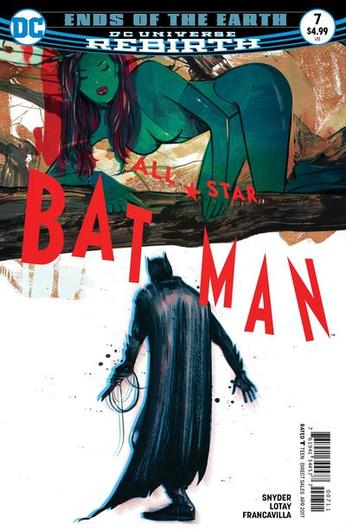 I’m going to be honest with you dear readers, I wasn’t very excited to read the Poison Ivy issue of All-Star Batman. Coming off such a powerhouse combination of Scott Snyder’s storytelling, Jock’s incredible artwork, and one of my favorite villains, Mr. Freeze, I didn’t think that Poison Ivy or artist Tula Lotay would interest me all that much. I was wrong. Where Jock captured the temperature and isolation of the Mr. Freeze storyline, Lotay makes issue 7 every bit as lush and colorful as it needs to be to mirror its central focus, which is impressive considering this section of the ‘Ends of the Earth’ arc takes place in Death Valley, Nevada. By and large my experience with Poison Ivy has not been a positive one. I believe the only comic book that I’ve read which featured the Pheromone Femme Fatale was her brief appearance in the 'Knightfall' story arc (an arc which I would wholeheartedly recommend as it features one of the most iconic moments in comic history, the breaking of Batman’s back). In Batman #495 'Strange Deadfellows' Ivy fights Batman with a host of entranced Gotham socialites who have fallen victim to her chemical charms and were interrupted as they rushed to give the object of their affection all their money. This is a similar storyline to what was probably my first introduction to Poison Ivy, the 'Eternal Youth' Episode of Batman: The Animated Series. In this episode Alfred visits a spa and is brainwashed into becoming a humanoid tree by Poison Ivy’s special brand of persuasion. These two storylines, a particularly scenery-chewing performance of Uma Thurman’s, and the Arkham series video games constitute the extent of my knowledge of Poison Ivy, which is probably why I was not too excited to see an Ivy-centric issue. Before reading issue 7, I thought of Ivy as a seductress without much substance, but Snyder breathed new life into the character for me by playing up the passionate researcher and toning down the seductive temptress. Ironically, shifting from Freeze to Ivy was not as jarring a transition as I was anticipating (remembering the awkward pairing of the two in 1997’s Batman and Robin) as Snyder reminded me that Victor Fries has an awful lot in common with Pamela Isley. They have very similar origin stories, scientific backgrounds, and go to environmental extremes in pursuit of their goals. The other refreshing aspect of Snyder’s Ivy is that Batman doesn’t have to thwart a world domination type scheme or have to fight through a horde of flora-infected goons to stop an extreme green world agenda in this story. He comes to Ivy in the midst of research, not scheming and we get to see a side of the femme fatale that is really endearing. Batman turns to Poison Ivy to assist him in containing the virus that Mr. Freeze had meant to unleash on humanity. Unfortunately, Batman’s clever response to Freeze’s plan in issue 6 wasn’t able to eradicate every microbe of the ancient plague and now a little girl’s life hangs in the balance. Still pursued by the mysterious strike team that caught up with him and Freeze in Alaska, Batman rushes to enlist Ivy’s help before both the young girl and Ivy’s research subject, an ancient descendant of the Tree of Life as Ivy refers to it, suffer messy ends. It is really impressive that after a 5-part story that shed so much light on the relationship between Harvey Two-Face and Batman, that Scott Snyder’s follow-up arc has been no less insightful. Using single issues and specific artists to capture the essence of a new villain each month, Snyder demonstrates that he is truly at home in the world of Batman. Whether he visits a member of the rogue’s gallery for a single issue, a five-month arc, or a panel-length cameo, All-Star Batman is in good hands with writer Scott Snyder. I also need to acknowledge Tula Lotay’s beautiful work with colors and contrast. The desolation she creates in her desert scenery and the cloud of color that follows Ivy from panel to panel are skillfully executed and add so much to the issue. Ivy's research tent is a lush oasis in the middle of a barren wasteland and I will definitely be keeping an eye out for more of Lotay’s work from now on. Next month Batman takes on the Mad Hatter! Until next time, Geek On! Written by Joel T. Lewis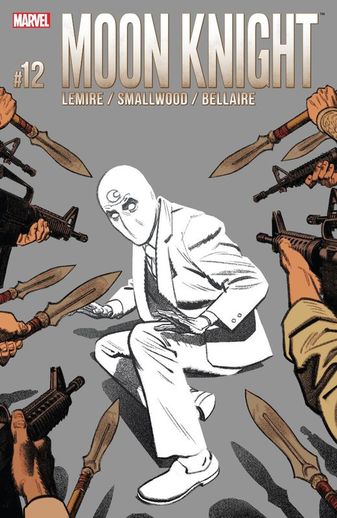 Issue 12 of Moon Knight marks the triumphant return of Moon Knight’s alter-egos. Seconds away from being eviscerated at the request of an angry mob in the Othervoid, Marc Spector is rescued by a crescent moon dart thrown by a familiar face: Moon Knight. The bizarre plane of the Othervoid allows Spector’s identities to come to his aid, as Moon Knight steps up to duke it out with the bloodthirsty guards, Steve Grant rescues Anput, and Captain Marc Spector appears with his starfighter to fly them all to safety. After their poignant parting in issue 9, their reunion with Spector is timely and heart-warming as Moon Knight asks, “Did you really think that we ever left?” This reunion is important because it reminds us that Marc is not alone in his fight, and his alternate personalities acknowledge their role as an internal support system and not as an external distraction. Bidding them fond farewell, Spector returns Anubis’ wife to him and frees Crawley. Anubis then fulfills his promise to ferry them back to where this all began. On the origin side of this issue, Lemire treats us to a snapshot of Marc the Mercenary, following Spector and DuChamp on a snatch-and-grab operation in Saudi Arabia. This portion of the Spector origin story almost reads like a James Bond cold-open; showcasing a hero who keeps his cool and adapts to complications in the middle of an operation. Spector and Frenchie have been hired to extract a heroin dealer known as the Wolf and deliver him to persons unknown. I’m not sure what Marvel are planning for after Jeff Lemire leaves Moon Knight (holding back tears), but this issue made me think that a team-up series depicting the mercenary exploits of Spector and DuChamp could be a lot of fun (Maybe they could call it Marc Spector: Mercenary in honor of the second Moon Knight series). Something that really made these panels standout, especially next to the topsy-turvy Othervoid pages, was the use of color. I have given a lot of credit to everyone who has been a part of this series, but I have neglected one of the most important team members who has made these beautiful issues vibrant and complex: colorist Jordie Bellaire. When a comic’s title character has a white suit as his signature costume you wouldn’t expect a colorist’s job to be that involved. But in this series we’ve seen Bellaire’s skill as she’s adapted to multiple artist's styles, colorful settings, and unique characters. Her contributions really make the panels pop whether they take place in the asylum, on the sands of New Egypt, or within the Othervoid. In this issue Bellaire shines as Spector infiltrates the Wolf’s secret backroom operation. The blue tint of these panels sets up a great cooling contrast to the desert warmth of the panels before and harkens back to the techno-noir style of Francesco Francavilla earlier in the series. It’s a true testament to Bellaire’s skill as a colorist for a panel to convey temperature so effectively and she’s done a wonderful job on this series. When I praise these flashback panels, I am of course neglecting to mention the incredible work Bellaire has done to bring the bizarre Othervoid to life. The wash of galactic starlight which characterizes every frame of this unique setting is breathtaking and Bellaire is responsible for bringing those panels into the light. Throughout this series there have been several subtle touches that reference the spirit of the Moon Knight mythos. One that came to light in this issue was the way Marc Spector feels about his mercenary work. In the 1980 Moon Knight origin story it is made very clear that while Marc Spector commits violent acts as a mercenary, he does not take pleasure in making people suffer. He is a military operative first and in the first issue of the 1980’s series when he discovers that he’s been made to fight for the wrong side, he refuses to continue. Sure, he operates outside the law but he is not a malicious man and he has drawn a line in the sand he will not cross. Jeff Lemire’s Marc Spector holds the same stance. When we see Marc in the bare-knuckle boxing ring last issue he holds back from killing his opponent despite the bloodlust of the crowd. Also, when confronted by the heroin dealer the Wolf about being a mercenary, Spector responds by reminding his captive that while he may be a mercenary at least he doesn’t destroy lives like the Wolf does. I’ve always found this component of Spector’s past to be very important. Though in many ways Moon Knight’s vigilantism was a way of making up for the violence of his mercenary past, Spector was never evil or vicious despite operating in a moral grey area. This is why he is redeemable and ultimately forgiven by Marlene in the original origin and it’s very wise of Lemire to establish that common thread in this issue. Next month we get to sink our teeth into one of the most ruthless villains in comics and Moon Knight’s arch-nemesis: Raoul Bushman. Until next time, Geek On! --This article has been updated to correct and earlier mistake where artist Jordie Bellaire was incorrectly referred to as a male, when it fact Jordie is a woman. Our apologies to Jordie for this mistake.-- |
Archives
May 2024
|
|
© 2012-2025, Nerds That Geek LLC.
All Rights Reserved. |
uWeb Hosting by FatCow
